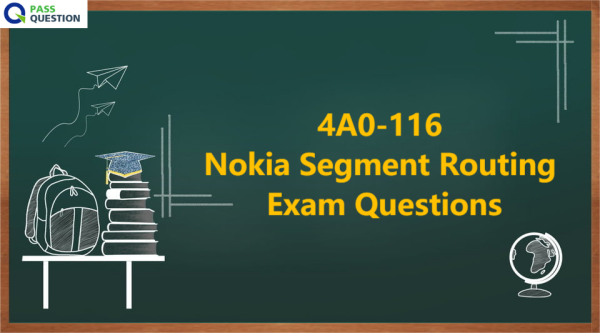4A0-116 Nokia Segment Routing Exam Questions
To prepare for this Nokia Segment Routing Exam 4A0-116, it is essential to have a comprehensive and thorough understanding of segment routing technology. We now released 4A0-116 Nokia Segment Routing Exam Questions which are designed to provide candidates with an authentic and realistic exam experience, as well as to test their knowledge and understanding of segment routing. If you are preparing for the Nokia Segment Routing Exam 4A0-116, we highly recommend our 4A0-116 Nokia Segment Routing Exam Questions to help you pass the Nokia 4A0-116 exam with flying colors.

Exam Details
Exam name: Nokia Segment Routing Exam
Exam number: 4A0-116
Mandatory prerequisites: none
Exam duration: 90 Minutes
Exam appointment duration: 120 minutes. This is the exam duration plus a 45-minute tutorial on computer-based examinations.
Number of questions: 40
Language: English
Price: $125 US
Exam Topics
Module 1 - Introduction to segment routing
Drivers for the use of data tunneling
MPLS data encapsulation and forwarding
Segments, segment IDs and segment routing
Differences between segment routing and other traditional MPLS label signaling protocols
Segment ID values
Module 2 - Basic segment routing configuration and operation
Link-state routing protocol extensions to support segment routing
Configuring IS-IS to support segment routing
Configuring OSPF to support segment routing
Using segment routing tunnels that follow the IGP shortest path
Module 3 - Segment routing tunnels with traffic engineering constraints
Traffic engineering fundamentals
Enabling traffic engineering
Link-state routing protocol extensions to support traffic engineering
Configuring IS-IS to advertise TE information
Configuring OSPF to advertise TE information
Local calculation of a TE-constrained LSP path
Configuring segment routing LSPs with traffic engineering constraints
Label stack reduction for CSPF-calculated paths
Secondary LSP paths and seamless-BFD
Retry-on-error vs resignal behavior
LSP path preference
Ensuring LSP path diversity
Using segment routing tunnels with TE constraints (SR-TE)
Module 4 - SR-TE with a path computation element
Path Computation Element (PCE)
Path Computation Element Protocol (PCEP)
The Nokia Network Services Platform (NSP)
Configuring segment routing LSPs calculated by the PCE
Module 5 - Segment routing fast re-route
Loop-Free Alternate (LFA) paths
Enabling segment routing fast re-route
Remote Loop-Free Alternate (R-LFA) paths
Directed Loop-Free Alternate (D-LFA) paths
Topology-Independent Loop-Free Alternate (TI-LFA) paths
Precedence of the different LFA options
Module 6 - Flexible algorithms (flex-algo)
Flexible algorithm basics
Flexible algorithm configuration
Advertisement of flex-algo information by IS-IS
Advertisement of flex-algo information by OSPF
Fast re-route for flex-algo instances
Steering traffic into flex-algo segment routing tunnels
View Online Nokia Segment Routing Exam 4A0-116 Free Questions
1. Which of the following statements about segment routing fast re-route is FALSE?
A.Fast re-route is a temporary fix that becomes active for a short period of time after a local network failure.
B.Fast re-route typically protects the active segment of a tunnel, but under certain conditions it can protect an end-to-end multi-segment tunnel instead.
C.On a Nokia 7750 SR, R-LFA and TI-LFA can be enabled independently of each other.
D.The parameter 'max-sr-frr-labels' limits the number of labels that R-LFA can add to the data packet encapsulation.
Answer: C
2. In the context of a network that includes a Path Computation Element (PCE), what is a PCC-initiated LSP?
A.An LSP that needs to be explicitly configured on the head-end router.
B.An LSP for which the initial path is calculated by the head-end router.
C.An LSP for which the path repairs and re-optimizations must be triggered by the head-end router.
D.An LSP whose existence and state are reported to the PCE.
Answer: D
3. Which of the following is NOT an advantage of using a PCE for the computation of TE-constrained LSP paths, as compared to using CSPF locally on the PE router?
A.The ability to create cross-area TE-constrained LSP paths
B.The ability to create LSP paths with bandwidth reservation
C.The ability to create LSPs with primary and secondary paths
D.The ability to ensure that some LSP paths are disjoint
Answer: B
4. Which of the following types of information is considered by a stateless PCE when it processes a new LSP path calculation request?
A.The IGP link-state database
B.The traffic-engineering database
C.The operational state of existing LSP paths
D.The amount of bandwidth reserved for each of the existing LSP paths
Answer : A
5. Which of the following statements about the Path Computation Element (PCE) is FALSE?
A.The PCE can obtain topology and traffic-engineering information from the network using either a link-state IGP or BGP-LS.
B.A stateful PCE proactively monitors all the existing LSPs and triggers the necessary repairs and re-optimizations.
C.A stateless PCE can calculate cross-area traffic-engineering-constrained LSP paths.
D.A stateful PCE can allow LSPs to reserve bandwidth.
Answer: D
6. Which of the following list of SR-TE attributes has to be advertised among routers?
A.Administrative groups that each link belongs to, TE metric of links, bandwidth availability of each link, SRLG that each link belongs to.
B.Administrative groups that each link belongs to, TE metric of links, SRLG that each link belongs to.
C.Administrative groups that each link belongs to, TE metric of links, bandwidth availability of each link, SRLG that each link belongs to, link status up/down.
D.Administrative groups that each link belongs to, TE metric of links, SRLG that each link belongs to, link status up/down.
Answer: A
- TOP 50 Exam Questions
-
Exam
All copyrights reserved 2025 PassQuestion NETWORK CO.,LIMITED. All Rights Reserved.

